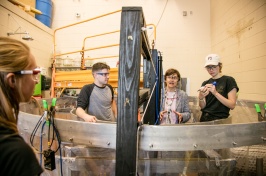UNH Space Scientist Honored by European Geosciences Union

Noé Lugaz, a research assistant professor in the University of New Hampshire's Institute for the Study of Earth, Oceans, and Space, has been awarded the 2014 Arne Richter Award for Outstanding Young Scientists by the European Geosciences Union.
DURHAM, NH -- Noé Lugaz, a research assistant professor in the University of New Hampshire's Institute for the Study of Earth, Oceans, and Space, has been awarded the 2014 Arne Richter Award for Outstanding Young Scientists by the European Geosciences Union. The award will be presented at the EGU 2014 General Assembly meeting April 27 - May 2, 2014 in Vienna where Lugaz will give an award lecture.
The Richter Award recognizes scientific achievements in any field of the geosciences made by a scientist under the age of 35. Four Outstanding Young Scientists awards were announced this year by the EGU, which is Europe's premier geosciences union with over 12,500 members worldwide.
Lugaz, a native of Paris, France, is being recognized by the EGU for his breakthrough advances in the study of coronal mass ejections. CMEs are explosive solar eruptions that can send more than a billion tons of the sun's outer atmosphere hurtling into space and can severely impact satellites, polar-orbiting aircraft, and ground-based power stations.
According to the EGU citation, Lugaz's work bridges the gap between computational and observational solar-terrestrial physics by developing sophisticated numerical models to simulate CME expulsion and propagation in the interplanetary medium between the sun and the Earth.
A specific emphasis of his research, which he has been conducting since his Ph.D. dissertation, has been the study/investigation of the interaction of multiple CMEs, which provides a new view crucial to solar physics as to how an extreme space weather event can arise from a combination of multiple solar eruptions.
Lugaz has also made extensive use of the remote imaging capabilities of the Sun-Earth Connection Coronal and Heliospheric Investigation (SECCHI) instrument suite on the STEREO (Solar TErrestrial RElations Observatory) spacecraft, for which he developed novel techniques.
A groundbreaking piece of work was his method of analyzing SECCHI observations for predicting the arrival of CMEs at Earth—a method that has been shown on many occasions to give the most accurate prediction and which is now widely used in the solar-terrestrial physics community. The prediction of CME impact at Earth is crucial if society is to protect both space- and ground-based technological infrastructure.
The Richter Award also recognizes Lugaz for contributions he's made through authoring or co-authoring over 30 peer-reviewed articles, some of which are widely quoted.
The STEREO mission, launched in October 2006, is comprised of two, nearly identical spacecraft the size of golf carts and, among other instruments, carries the PLAsma and Supra-Thermal Ion Composition (PLASTIC) instrument built at UNH. STEREO's observations enable scientists to construct the first-ever three-dimensional views of the sun.
For more information on the STEREO mission, visit http://stereo.sr.unh.edu.
The STEREO mission is managed by NASA's Goddard Space Flight Center. The Johns Hopkins University Applied Physics Laboratory designed and built the spacecraft.
The University of New Hampshire, founded in 1866, is a world-class public research university with the feel of a New England liberal arts college. A land, sea, and space-grant university, UNH is the state's flagship public institution, enrolling 12,300 undergraduate and 2,200 graduate students.
Photograph to download: http://www.eos.unh.edu/newsimage/noe_lg.jpg
Caption: Noé Lugaz. Courtesy of Noé Lugaz.
Latest News
-
October 30, 2024
-
October 10, 2024
-
October 8, 2024
-
October 3, 2024
-
October 1, 2024
















































